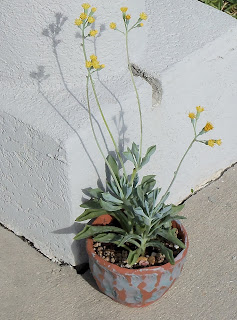Succulent expert Fred Dortort says the Adromischus genus comprise " ...a low-key but significant portion of the South African succulent flora." (
Succulent Plants of the World, pg. 52) Crassulas will take over the world, bwahhahaa...! But seriously, these are tough little plants, beautiful, and easy to grow. This one is known as the Key Lime Pie, Pie Crust, or Crinkle Leaf plant, depending on where you live. Since Key Lime Pie is our state dessert (yum!), that's its name here.
 |
| Adromischus cristatus |
The leaves are fuzzy, wedge-shaped and plump, with lovely crinkles at the end. The crinkled edges turn slightly red when it's getting enough light. A. cristatus grows bright red, adventitious roots along the stems.
It likes bright light, but too much sun and heat will cause it to bleach and wrinkle in a very sad manner. It needs to be watered when the soil dries out, and should be planted in standard succulent/cactus soil with excellent drainage. You can grow new ones from leaf cuttings.
I made a few new drainage trays for my succulent collection. They are stoneware with Ancient Jasper glaze, which seem to suit the plants well.
New trays for the Key Lime Pies! (plants, that is)






















